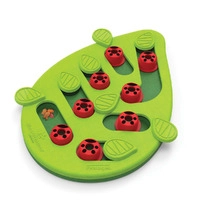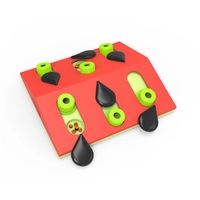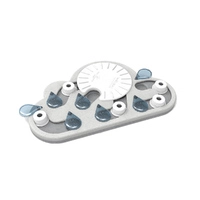Unlocking Fun and Health: Our Guide to Feline Feeder Toys
- Carolyn O'Brien
- Mar 5, 2024
- 3 min read
Updated: May 25, 2024
Have you ever noticed your furry friend zooming around the house at lightning speed, only to crash and spend the rest of the day snoozing in the sunniest spot they can find? Cats, with their mysterious and playful nature, possess an instinctive urge to hunt and explore. But when their world is limited to the indoors, how do we keep their minds sharp and bodies healthy? Enter the world of feline feeder toys: a game-changer for indoor cats everywhere.

What Are Feline Feeder Toys?
Feline feeder toys, also known as food puzzles, are designed to simulate the hunting experience for indoor cats. These nifty devices challenge cats to work for their food, engaging their brains and bodies in the process. From simple balls that dispense kibble as they roll to more complex puzzles that require pawing, pushing, and problem-solving, these toys turn mealtime into playtime.
The Benefits of Feeder Toys for Cats
- Mental Stimulation: Just like humans, cats need to keep their brains active to stay healthy. Solving the puzzle of a feeder toy provides mental stimulation, keeping boredom at bay and reducing stress-related behaviors.
- Physical Exercise: Chasing and batting at feeder toys encourage physical activity, helping your cat maintain a healthy weight and improving their overall physical health.
- Controlled Eating: For cats who tend to gobble their food too quickly, feeder toys slow down eating, aiding digestion and preventing obesity.
- Behavioural Improvement: Engaging with feeder toys can help reduce common behavioural issues, such as aggression or excessive meowing, by providing a constructive outlet for their energy.

Choosing the Right Feeder Toy:
When selecting a feeder toy for your cat, consider their age, health, and play preferences. Start with simpler toys to gauge their interest and gradually introduce more complex puzzles to keep them engaged. It's also essential to choose toys that are durable and safe, without small parts that could be swallowed.
An excellent resource that we direct many of our clients to is the website Food Puzzles for Cats. This is a comprehensive resource created by two feline behaviourists following their publication of a popular research paper in the Journal of Feline Medicine and Surgery. The site is regularly updated with new content and does not endorse specific brands, focusing instead on facilitating environmental enrichment for cats.
Tips for Introducing Feeder Toys:
Start Easy:
Begin with an easy toy to ensure your cat understands the concept. Once they get the hang of it, you can introduce more challenging puzzles. Ideally your cat should start with clear puzzles with many openings so that cats can see, smell, and hear that there is food inside and will be rewarded with food for even gently nudging it.
Puzzles should be at least one-half to three-quarters of the way full so the food easily dispenses. An almost empty puzzle can be too challenging and create frustration.
If dry food is fed, sprinkle some around the puzzle so the cat can acquire a few pieces and nudge the puzzle for more. Your cat will make the connection between moving the puzzle and obtaining food.
For slow starters, place small handfuls of dry food in locations frequented by the cat (condos, windowsills, beds) as this allows the cat to discover food in novel places.
Mix It Up:
Keep things interesting by rotating the toys regularly. This prevents boredom and keeps your cat excited about mealtime.
Be Patient:
Some cats may take longer to warm up to feeder toys. Encourage them with treats and praise, but don't force it. The goal is to make mealtime fun and rewarding.
Our Favourite Commercial Feeder Toys (Available in Our Clinic):
Nina Ottosson Cat Puzzle Range:
KONG Range:
Northmate Catch Interactive Slow Feeder:
DIY Feeder Toy Ideas:
Feeling crafty? You can create simple feeder toys at home.
A cardboard box with holes cut out for pawing at treats inside, or a toilet paper roll pinched at the ends to hold kibble, can be just as engaging as store-bought toys.
For stationary puzzles begin with egg cartons, muffin pans or ice cube trays. Muffin pans and ice cube trays are well-suited for use with wet food.
In Conclusion
Feline feeder toys are more than just playthings; they're tools to enrich your cat's life, promoting physical and mental health through the joy of play. By incorporating these toys into your cat's routine, you're not just feeding their belly; you're feeding their instinctual needs and strengthening the bond you share. So, why not give them a try?
Your cat will thank you with purrs of appreciation and hours of entertained play. Remember, always consult with a veterinarian before making changes to your pet's diet or introducing new toys, especially if your cat has specific health concerns. Happy playing!
NB: This is a guide only based on our experience - we're not paid by any of the companies mentioned. Availability of individual commercially made toys may change over time.











